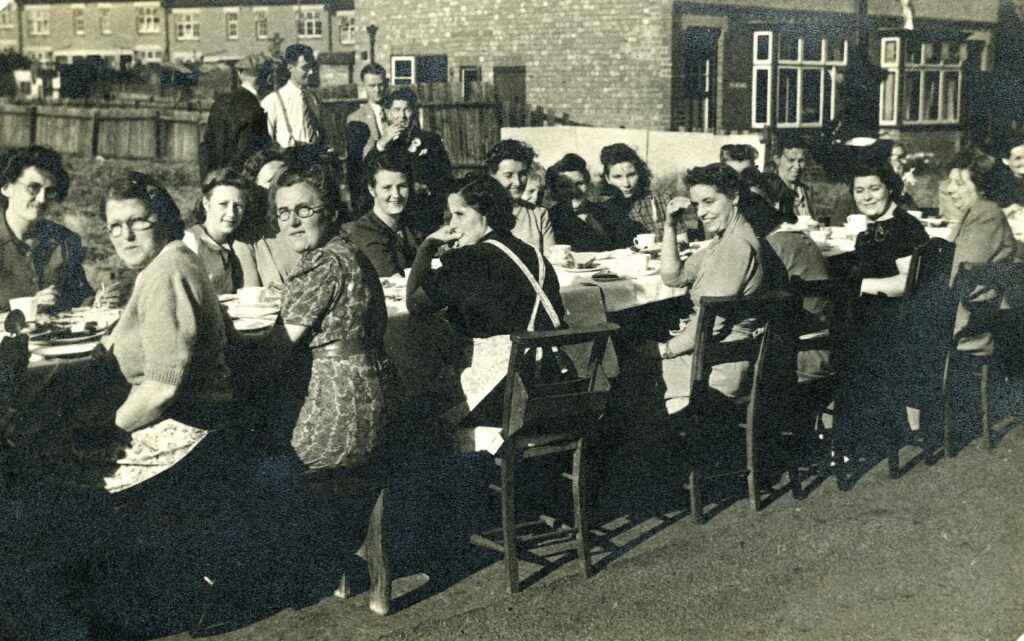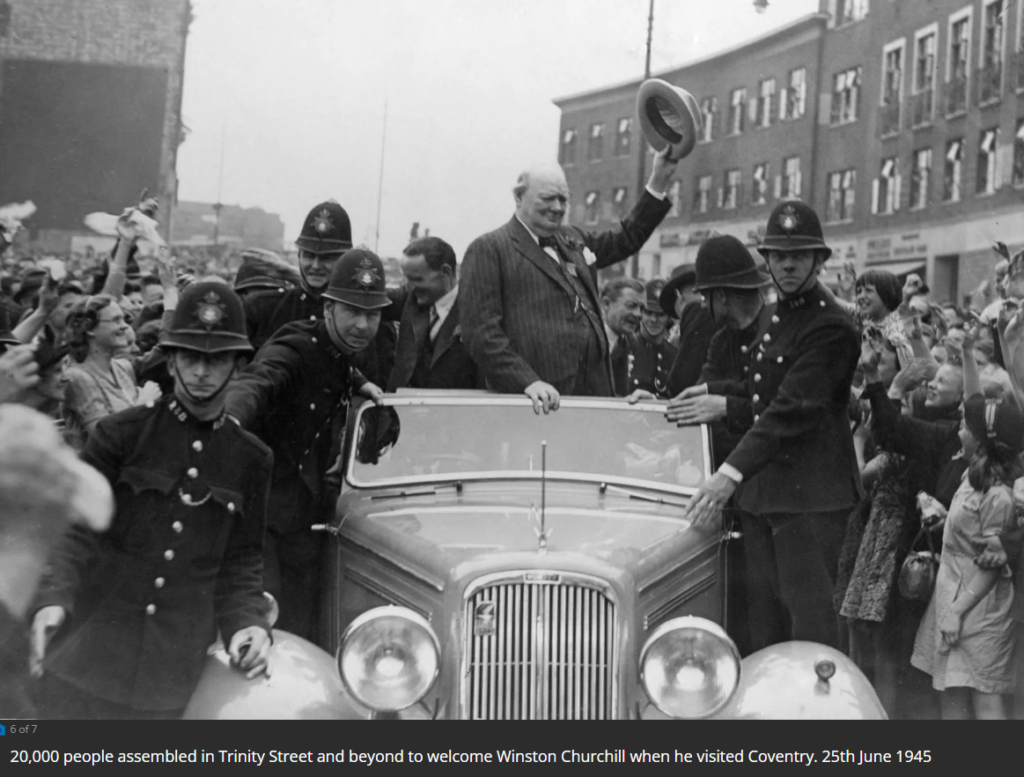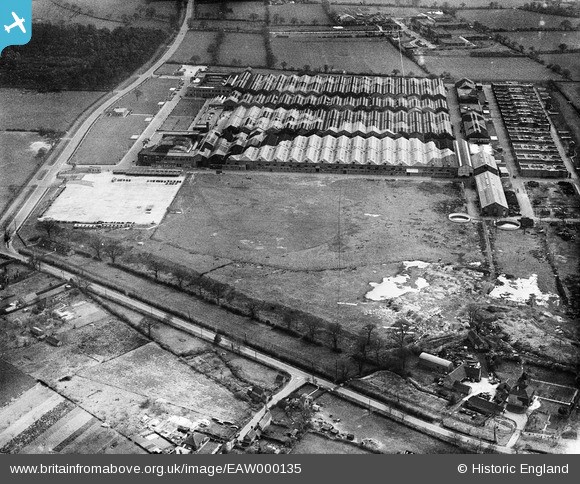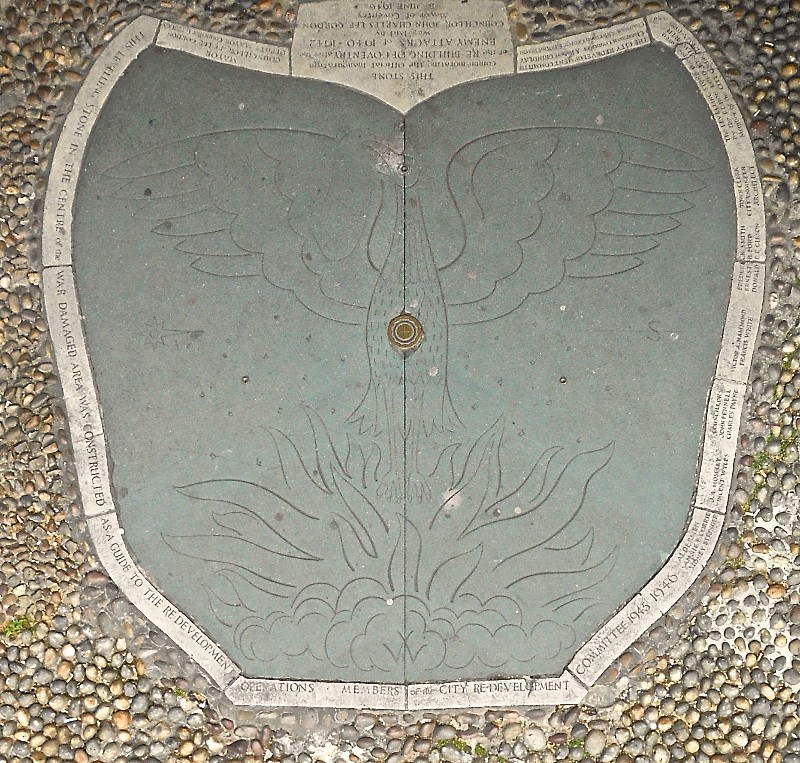Historian and CovSoc Committee member, David Fry, has been studying past editions of the Alfred Herbert Newsletter. These newsletters are much more than just a works newsletter and reveal a lot about the thinking in the city at the time they were written. The article below is extracted from 1956 editions of the newsletter, looking back at the end of the War in1945, and is written in the words of the authors. David writes….

Imagine what it was like when the war ended. For a time the population were euphoric. The bad old days would be in the past, life would get better. However, reality soon dawned – the country massively in debt, many in poverty with food rationed for the foreseeable future, national strikes…. Perhaps not so difficult for us to imagine eighty years later!
Great were the rejoicings on that historic day which brought peace to Europe. The two following days, May 8th and 9th, were declared national holidays and all over the country work was set aside for the once in a great wave of thanksgiving and rejoicing.
And nowhere was it more heartfelt than in Coventry where the full rigours of war had been felt. The whole of the city was gaily beflagged, and at night the centre floodlit, and for two days the people danced and sang to the accompaniment of bands and orchestras in the parks and open spaces.
Everywhere too, despite the rationing, street parties were in full swing and people ransacked their larders of their precious hoarded treasures so that the tables groaned under such an array of good things as had not been seen for many a day.
And yet, throughout the days of rejoicing, there was a continual stream of people wending its way into the war-ravaged shell of the cathedral, where services of thanksgiving were being held. All had reason to be thankful that the European holacaust had ended, but thousands had need of spiritual comfort for great had been the sacrifice demanded of Coventry. Hardly a home there was that could not say with sorrowing pride, “Greater love hath no man than this’.
On the following day work was resumed. Britain was no longer threatened with immediate danger but her sons were still fighting on the other side of the world where the war still raged.
The job was not yet complete!
On Sunday, May 13th, a great public service of thanksgiving, attended by 20,000 people, was held in the Memorial Park. In it mingled the pageantry of the Old World and the New, for the City Councillors attended in their civic robes, while at the head of the march past of 7,000 members of the armed forces and civil defence was an American military band leading a contingent of 400 American troops.
Shortly after this, the Labour Party declared itself unable any longer to support the Coalition Government, despite Churchill’s plea for its continuance until the war with Japan was over.
As a result, on May 23rd, Mr. Churchill tendered his resignation to the King, and the government, which had so successfully guided the country through its “finest hour” was no more. Of this event, the “New York Daily News” said, “If Mr. Churchill and his party do not win the election there is no gratitude”.
In the meantime, Japan was feeling the full weight of war and heavy raids on Tokio, Osaka and Nagoya had rendered millions homeless.
On June 25th, Mr. Churchill, in his election tour, visited Coventry when over 20,000 people thronged Trinity Street and vicinity to see and hear this great leader.

Early in the following month, on July 9th, a disastrous fire broke out in the 600 years-old bomb-scarred St. John’s Church. The fire, which was detected at 4 a.m., was thought to have been caused by a faulty electric cable in the organ loft. The organ was totally destroyed and the Lady Chapel and vestry seriously damaged, and later the damage was assessed at some £45,000.
On July 26th, the result of the polling was declared and the Labour Party was returned with a majority of over 200 members.
As the local Coventry newspaper said on the following day, “The British public has not yet recovered from its astonishment at what it has done in one of its most inscrutable moments”.
Whatever it had done, gratitude had played no part in it.
And now came the dawn of a new era, the atomic age. On August 6th, an atomic bomb was dropped on Hiroshima. The devastation was of awe-inspiring magnitude, and it was estimated that 120,000 people were killed and 118,000 injured, while Tokio radio announced, “The city is a disastrous ruin”. A few days later Nagasaki was also laid waste by a second bomb.
Bereft of her fleet and air force and open to absolute extinction by the atom bomb, Japan surrendered on August 15th. The war was finally over!
This time the rejoicing was world-wide. VE Day had only brought the war in Europe to an end but VJ Day signalled the total collapse of the enemy. As before, Coventry gave itself up to joyful revelry and everywhere huge crowds swarmed and bonfires blazed.
On September 2nd, the documents of surrender were signed—significantly enough —aboard H.M.S. Nelson in Tokyo Bay, and September 3rd, the sixth anniversary of the outbreak of the war, brought the first day of the post-war world.
Whither Britain?
Would the post war years bring the brave new world that had been so eagerly anticipated after the First World War, or would the reality turn out to be as grim as that period had done?
It seemed that the pattern would follow as before, for already apprehension was rife over unemployment even though, at the same time, the Government was already being urged to speed up demobilisation.
By September 10th, the unemployed figure had reached 2,000 and two weeks later it had risen to 3,000.
On October 4th, Sir John Black made an announcement which was eagerly greeted by all in Coventry. He said that his firm, the Standard Motor Co. Ltd., had acquired the shadow factory in Banner Lane where it was intended to manufacture the world-famous Ferguson Tractor, thus bringing an entirely new industry to Coventry. As unemployment was slowly but surely mounting this was news of the greatest interest.

The city’s interest was further aroused— by a very different subject—when on October 8th, an exhibition entitled “Coventry of the Future” was held at the Drill Hall.
By means of first-class drawings and scale models, an excellent idea was given of the trend of planning of the proposed new city. Mr. L. Silkin, the Minister of Town and Country Planning was deeply interested in the exhibition and came in person to open it, and the fact that the people of Coventry were also deeply interested was amply demonstrated by the fact that it was seen by over 57,000 people during the fortnight that it was open.
Now there commenced a period of industrial unrest that was to do the country untold harm. It began with a strike of the dock workers which, by October 13th had practically paralysed all shipping, for by that time 44,000 dockers had ceased work. As a result, all exports were blocked and troops had to be called in to unload food which was in short supply, for Britain was still on rations.
It was at this period too that, in an endeavour to supply the homes that the city so desperately needed, the first prefabricated houses were erected in Cheylesmore.
It was not until November 5th that the dockers’ strike ended, during which period great harm had been done to our export trade, particularly the motor car trade which was just getting into its post-war stride, with the result that inevitably unemployment continued to increase.
Meanwhile, the ghastly bestialities that had been practised in Belsen and the other prison camps were being gradually unfolded as the trials of the war criminals slowly proceeded.
On December 20th, the first of the Labour Government’s great plans to nationalise industry was proclaimed when the Coal Industries’ Nationalisation Bill was published.
And so came the first Christmas of peace since 1938. Of it was said, “A Merry Christmas—if you can afford it”, while the general verdict was that it was the “worst Christmas ever”. Everything was in extremely short supply, while black-market prices were almost prohibitive, so that, for most people it was the most austere Christmas since the outbreak of war.
Nevertheless, it is interesting to recall that advertisements of the time showed that a Ford 10 h.p. Prefect could be bought for £352 2s. 9d., while whisky was 25/9d. a bottle and cigarettes 20 for 2/4d.
The year 1946 ushered in a renewed feeling of unrest and disquiet. It seemed there were not enough houses, not enough food, not enough employment, not enough anything. Undoubtedly, the brave new world under a brand new government seemed to the victors of World War II not exactly what it might be.
This feeling was soon crystallised when on January 18th, 3,000 workers at the Humber started a go-slow strike in a bid for higher wages. On the 22nd, 2,000 men from the Daimler also went on strike for higher wages and were joined by 1,000 more in the following week.
On the last day of the month, the National Coal Bill was passed and 850 collieries, employing 700,000 men passed, for good or ill, into the control of the Government.
On February 7th, 6,000 Coventry engineers staged a half-day token strike in support of the Daimler strikers and at the same time the A.E.U. formulated a demand for a 40 hour five-day week together with an increase of £1 per week.
This demand—and the strike—seemed rather ironic, seeing that Sir Stafford Cripps, the President of the Board of Trade was even then saying at the Birmingham Trades Council that, “the salvation of the country lies only in increased production”.
The Daimler strike ended on February 12th but as if to counteract the comfort this brought to many Coventry homes, Mr. E. Shinwell, Minister of Fuel, said, “Unless output rises and continues to rise we are in sight of actual stoppage of factories for lack of power”.
Neither was the picture of gloom lightened by Mr. T. Williams, Minister of Agriculture, who, only the day following Mr. Shinwell’s dismal utterance, said, “The period of food shortage had now developed grievously beyond our fears”.
On February 23rd, the Humber go-slow strikers decided to strike, and on March 12th the shop stewards—against the advice of their Trades Unions—called for a withdrawal of all labour from 80 Coventry engineering and motor firms in support of the Humber strikers’ demands. Fortunately, the workers ignored this irresponsible demand and nine days later the Humber strikers returned to work.
More dismal news followed on May 1st. On that day the Midland Daily Telegraph said, “Food is in the news again. An Order giving effect to the cut in the weight of the loaf has been signed and will become operative from next Sunday. From that date the public will pay the same price for If Ibs. of bread as has been charged for 2 Ibs”. At the same time the cheese ration was cut from 3 ozs. to 2 ozs.
The following day the Coventry Chamber of Commerce stressed the literal gloominess of the times by urging that it was time that the ban on shop-window lighting was lifted.
Nor was the general picture helped by a statement in the House of Commons on the following day when it was said, “Unfortunately the unemployed are increasing at an alarming rate. In March 1946 the figure was 371,900”.
On May 14th, the Coventry Cathedral Reconstruction Fund was opened, and Their Majesties graciously donated £500 towards it. The cost of the new Cathedral was estimated at £1,200,000, of which the War Damage Commission was paying £500,000. Queen Mary gave a most unusual donation —the exquisite Bible which had been presented to her by the Y.W.C.A. on the occasion of her marriage in 1893. And still more gloomy grew the general prospect.
On June 1st, the new National Coal Board came in for sharp criticism when it was announced that Coventry’s coal prospects for the winter were likely to be worse than during the war. Three days later the Minister of Agriculture announced heavy cuts in livestock rationing, a situation which he himself described as “Very tragic—almost disastrous”.
Under the circumstances it did not seem at all out of place when the weather contributed its quota of gloom to the festivities that should have marked Victory Day— June 8th—for rain stopped practically all outside activities.
And yet, for all that, it was for Coventry a very significant day.
At 11.15 a.m., a procession of civic dignitaries in their robes of office left the Council House and proceeded to a spot near to where old Market Street had been. At 11.30 the National Anthem was sung by the waiting crowd and then the Mayor’s daughter unveiled the Levelling Stone.
After Lord Kenilworth had sealed in a silver casket various records of the day, he placed it in a cavity after which the Levelling Stone was lowered and the Mayor symbolically tapped it into position with a trowel.
The Levelling Stone—from which all the levels of the new Coventry were to be calculated was declared well and truly laid.

The reconstruction of Coventry had begun!
By June 15th, a report in the local paper made it obvious that the food situation was deteriorating yet further. The report told of, “Men and women fighting to force their way into a store at closing time to obtain oranges, and wild scrambles in the Barracks Square for tomatoes yesterday brought to an end a week of shortages described by a trade representative as being the worst since the war”.
On the 23rd, the soap ration was reduced and on the 27th the worst blow of all fell. It was announced that on July 21st, bread would be rationed.
It seemed incredible. After surviving the deprivations consequent upon total war, the coming of peace had brought us not plenty, but less than ever before.
In marked contrast to all this however, the trade outlook for Coventry seemed brighter. The unemployment figures had fallen to their lowest since the war had ended and a definite labour shortage in various skilled jobs was making itself felt. During its long history, Coventry had faced many difficult situations, but now it seemed as though the most paradoxical of them all were about to develop—the city seemed likely to starve in the midst of plenty.
